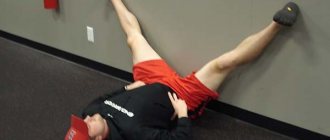Ruslan Sher, founder of the SherBootCamp training project :
“Why is working out together cool, productive and fun? This is something that will give you extra motivation and energy when you are tired or, God forbid, want to skip a workout. The moment of gaining real strength and feeling your partner’s shoulder when you hear “Come on again!”, “Kamon!”, “You can do it!” coming from a partner who is giving it his all with you is priceless. It is then that you truly feel like an athlete, a champion, a winner on the court or in the gym. And, of course, these are emotions and endorphins, so choose a cheerful and cheerful partner, so that in addition to your physical strength, you fill each other with smiles.”
All exercises can be performed either by time: for example, if you are a beginner, then from 30 seconds, then change (repeat the partner’s position) and move on to the next exercise. If you have an intermediate and advanced level, then feel free to set the timer for a minute. Then you can increase the time under load. Or do a set of 10 repetitions of each movement and move on to the next one - this is for beginners, intermediate - 20 repetitions, advanced - 30 repetitions (here, of course, you will have to work hard). The number of approaches can be distributed as follows: 1–2 – for beginners, 2–4 – for intermediate ones; 4–5 - for advanced.
Exercise No. 3: “Car”
Both partners work together at once, motivating and encouraging each other. The first number, as usual, stands in a prone position, and his partner takes his legs. The first one should have the most even plank position (without arching in the back!) with the legs suspended. The second one stands straight and does not move, holding the partner’s legs (here your arms will be well pumped). And the first, standing in a suspended plank, begins to alternately touch his opposite shoulder with his palm, shifting from hand to hand (here you will feel not only your arms, but also your shoulders and abs with your back).
Exercise #4: Lunge in place with balance
Here you seem to be playing “Balancer” (a type of swing when one goes up and the other goes down, and vice versa). That is, you will have alternate work. You can increase the speed, trying to outplay and speed up your partner. One is at the bottom and the other is at the top, but essentially you're doing the same thing. We stand on one leg, the knee of the other leg is slightly bent and in front of us. Lunge them back so that both knees are at 90 degrees at the joints (femur relative to the tibia). In this case, the knee in front is above the foot, and the knee behind does not touch the surface, leaving a distance of 2–4 cm from the floor. We get up, that is, we return to the starting position, and lunge again. The emphasis is on balance at the top.
Pair training and its benefits
Let's highlight a number of the most important advantages of pair training.
- Variety . Such classes are never boring in principle. It has been scientifically proven that paired training promotes the production of the “happy hormone” endorphin , which is often not achieved when exercising alone.
- Additional motivation . Your training partner will always support and encourage you if you are tired or simply lazy. In addition, in such activities there is always a spirit of competition: who can do more pull-ups, push-ups, sit-ups, and so on.
- Insurance . When doing strength training, the help of a partner is not just a whim, but a necessity that will allow you to preserve your health.
- Additional stress on muscles . Fitness for two involves increasing the complexity of basic and well-known exercises. In this case, your partner will successfully perform the role of the simulator.
- Paired training is great to do with your other half. This will add variety to your life together and help strengthen your relationship . During joint sports activities, there will be an additional incentive to physically improve not only yourself, but also your partner.
Exercise No. 5: static squat + squat and 180 degree jump
The most powerful work of the hips of the two partners, motivating each other, energy, giving out high fives. The first number does a deep squat in a static position: feet shoulder-width apart, pelvis back, knees angle 90 degrees, and they are above the center of the foot (do not go beyond the toes!), arms in front of you. And the second one also does a squat, gives high fives to his partner, jumps up with a 180-degree turn, touches the floor with his hands, jumps back to the starting point, gives high fives - and again jumps with a turn. All leg muscles work, from the calves to the quadriceps and hamstrings.
Recommendations for pair training
Before moving on to considering the basic exercises for pair training, we will give a number of important recommendations, following which you will receive significantly greater benefits from your exercises.
- An ideal partner for joint training should be approximately equal to you in height and weight . For example, these could be two girls of the same build. If the height or weight of athletes differs by more than 10 centimeters and 10 kilograms, then certain adjustments should be made to pair training.
- If your partner is much taller and bigger than you , then this is not a reason to refuse to work together. For example, when performing vertical push-ups, ask your partner to sit on a chair or climb to a secure height (a threshold or step). Once at the same level as you (or lower), a more massive person will be forced to perform a bottom-up movement, which will significantly increase the load for him and balance your strength.
- If your partner is stronger and more resilient than you , then you can always turn this contrast to your benefit. To begin with, try to perform as many repetitions as both of you can do. With regular training, you will very soon begin to work as equals, and it remains to be seen which of the two of you will get tired first.
Reason #2. You can evaluate your partner’s body and physical capabilities in practice
Your lover has always boasted that he squeezes out a hundred and more than once. Now he has a great opportunity to personally demonstrate this and receive well-deserved compliments and encouragement from you. He is pleased that you are proud of him, you like that your partner is not an empty talker and a liar.
Aren't these feelings worth going to the gym together? Of course they are! You will also be able to show him your toned figure and toned muscles in the most attractive parts of your body. Let him also know that he can be proud of you. Although, we are sure, he will also be pleased to show off his pumped up biceps in front of you and briefly show off his six-pack abs.
Pair yoga for children
Children's pair yoga is a great way not only to have fun with your children, but also to improve your child's health.
In the process, children not only get a good stretch, but also learn to negotiate, help and understand each other.
Paired yoga will help children quickly get used to society and learn to interact with it.
Tell your child about what you will be doing so that he is not afraid during class. Many children believe that yoga means sitting with your eyes closed and breathing deeply. To keep your child from losing interest, tell him that yoga is much more interesting than static poses, and offer to at least try it.
How to interest a child in yoga?
If your child doesn't agree to do yoga, try these 3 ways.
- Come up with levels and a small prize that you will give to your child after completing all the levels. Let one asana be considered one level.
- Take an imaginary journey and talk to your child about his actions while he performs the asana. For example, while standing in tree pose, invite your child to imagine himself as his favorite tree. Tell your baby that there are a lot of baby squirrels living on it, so to prevent them from falling, you need to stand upright.
- Start doing yoga yourself in front of your child. The baby will be interested if the parents perform asanas, and he himself will join you.
3 yoga asanas for two children
Paired sukhasana
Children sit face to face and cross their legs in Turkish style. They should raise their arms parallel to the floor, turn their palms towards each other and join them. Invite the children to feel each other's breathing and try to breathe simultaneously and deeply. You can change the asana after 4 breaths.
To keep the kids from getting bored, you can include a mantra for them.
Tree pose
Children should stand shoulder to shoulder, raise one hand, which is closer to each other, up and bring them together. With the second hand, the kids hold the leg, which is bent at the knee.
To motivate children to maintain balance as long as possible, offer them a game: whoever falls first must complete the task.
Remind children that pushing is not allowed and that their main goal is to support each other.
Award a prize if kids can maintain their balance for 30 seconds.
Contraindications: leg injuries.
Bike
Children should lie down, raise their legs, connect each other's feet and bend opposite legs at the knees and bend each leg in turn.
Invite the children to imagine that they are riding an unusual bicycle. To make it more interesting for the kids, and for them to transform into real racers, turn on your imagination and voice the actions: “There is a steep uphill climb ahead, you slow down and save up your strength. Now you need to pedal faster to climb the mountain!”
Contraindications: knee and back injuries.
3 yoga asanas for two: parent and child
Hug sana
The cutest and most pleasant asana, which in 3 minutes will help you reconnect with your child and become closer. Just close your eyes and hug tightly. To enhance the effect, pat each other on the head and say that you love.
Parvatasana - mountain pose
What does a parent do? Lie on your stomach, place your palms towards your chest, and place your feet slightly wider than shoulder width. Smoothly lift your body up, straighten your arms, relax your neck and press your heels to the floor. The child can stand in the same position under or next to the parent.
Contraindications: spinal injuries, hypertension, neck injuries, lower back pain.
Airplane
Lie on your back, take the child by the hands, rest your feet on his pelvic bones and lift him above you. We promise that the child will be delighted - he will love the feeling of flying.
Contraindications: back, neck and pelvic injuries, hypertension.
Reason #11. You both know the ecstasy of a tasty cheat meal after a powerful workout.
We are all people, and we are characterized by simple human weaknesses. Just imagine: you’ve had a great workout, you’re pouring sweat, hunger no longer just makes itself known, but requires immediate absorption of food, and then the idea arises to eat something incredibly tasty, but not classified as “post-workout food,” for example. , ice cream. Common situation?
Ask your partner if he is thinking the same thing. It's so nice to eat what you want together after a productive workout.
Reason #9. You both no longer believe that the mystery powder in the jar is not nutrition.
It used to be that you perceived a protein powder cocktail as a fairy-tale potion from a Disney cartoon. Now, if he pounds something in a cup, it doesn’t bother you at all. Moreover, you are ready to drink this something yourself and even ask for a portion to be prepared for you. Magic, isn't it?
Sports nutrition can well dilute your usual diet, you no longer consider it a waste of money, and you even yourself have noted positive changes after using sports dietary supplements and complex vitamins.
Content
- 1 Exercises with a partner 1.1 Sprinting against resistance
- 1.2 Movement with an additional step overcoming resistance
- 1.3 Movement with an additional step touching the floor
- 1.4 Walking backwards against resistance
- 1.5 Push-ups against resistance
- 1.6 Wheelbarrow
- 1.7 Pull-ups with a partner
- 1.8 Around the world
- 1.9 Helmet press
- 1.10 Leg bend while lying on stomach
- 1.11 Bend both legs while lying on your stomach
- 1.12 Transporting the wounded
- 1.13 Strengthening the neck (left and right)
- 1.14 Strengthening the neck (forward and backward)
Main rules of classes
Many types of yoga have asanas suitable for beginners, so you can use simple practices as a basis that will suit the level of your partners. In order for yoga for two to bring maximum benefits to the body and mind, you need to follow four simple rules:
- Don't make sudden movements.
- If classes take place at home, you need to choose a room with enough space.
- Choose a yoga challenge for 2 people so that it contains suitable exercises for both of you.
- You need to enjoy your activities, and not work to the limit of your capabilities. Participants should feel comfortable while performing asanas.
Reason #1. Your partner is your support and insurance
Well, you won’t ask a stranger from the audience to back you up during deadlifts. Firstly, he also needs to train, and secondly, he may perceive this ambiguously, especially if the role of the requester is a fragile girl, and the request is directed to a massive athlete.
And the guy will be pleased to provide a reliable rear for his beautiful soulmate. Surely, it would be better for him to insure her than for that broad-shouldered athlete who is already looking in her direction.
So what do we have? Guaranteed safety and the most reliable insurance in the form of a partner, absence of unnecessary contacts from other athletes. And if so, then both have the opportunity to increase their working weight, since there is always reinsurance in case the forces were not calculated.
Benefits and Disadvantages of Stretching in Couples
Advantages:
- Helps increase the complexity and effectiveness of workouts.
- Helps improve mood by working in pairs.
- Helps diversify your training days.
- Speeds up results compared to single sessions.
Flaws:
- Training can take place in a group, so interaction with another person can only constrain , and mistrust can tighten the muscles, making it difficult to relax during stretching.
- High risk of injury. The whole point is that the second person, who puts pressure on the muscles of the other, does not feel the degree of load and pain of the partner, which threatens excessive impact on the muscle fibers, which can lead to injury.
Reason #4. You can take each other's turn at the gym
During peak hours, queues for exercise equipment are a very common problem at popular fitness centers. You don’t want to stand in it for half your workout, do you? Therefore, having a sports partner is an excellent way out of the situation.
He can take your turn behind him on the machine while you work out elsewhere. And then you just switch places, and there will be no downtime in training. Additionally, your significant other will help you wipe down the working parts of the machine before you start using it.
Yoga challenge for two
Do you want to try couples yoga, but don’t know how to organize a workout? Are you afraid that instead of doing yoga, you or your partner will choose to lie in bed longer in the morning?
To learn how to perform asanas and feel the results, you need additional motivation - arrange a yoga challenge and come up with a reward system.
Find 3 ideas on how to reward each other for completing a challenge.
- Have a romantic date. Restaurant, spa, horseback riding - the location doesn’t matter. The main goal is to strengthen the connection with each other that appeared during couples yoga.
- Buy something you've been dreaming of for a long time: a board game, tennis rackets or a music speaker. The thing will always remind you of how great you are for reaching the end of the challenge.
- If you are setting up a challenge for a child, promise him to go with him to an amusement park or to a quest.
Download the checklist and tick the training days.
To go deeper into yoga and learn about other asanas, sign up for a yoga course. Experienced teachers will teach you the correct technique for performing asanas and show you how to create sets of yoga exercises.
The cost of one yoga class is from 300 to 3,000 rubles. The price depends on the status of the school, the duration of the training and the course program.
2 tips on how to choose yoga courses
- Read reviews of different teachers and consult with friends who are already taking yoga classes. Sometimes reviews can say more than the program itself;
- Try trial training with different teachers before purchasing a full course. This way you will feel the teacher’s energy and understand whether it matches yours.
If you regularly practice hatha yoga, your body will thank you, and your internal changes will pleasantly surprise you. Don't be afraid to start - you will definitely succeed!
This training may be right for you:
- 10 Best Yoga Courses in St. Petersburg
- Best Yoga Training Courses from 1,200 Rubles
- 10 Best Stretching, Pilates and Yoga Courses
- 10 Best Yoga Studios in St. Petersburg
Tell us in the comments, have you already tried couples yoga? Repost so as not to lose the step-by-step plan of asanas for two.











